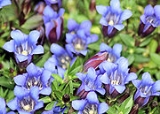Gentiana scabra is a species of flowering plant in the Gentian family (
GentianaceaeGentianaceae are a family of flowering plants of 87 genera and over 1500 species. Flowers are actinomorphic and bisexual with fused sepals and petals. The stamens are attached to the inside of the petals and alternate with the corolla lobes. There is a glandular disk at the base of the gynoecium,...
), found in much of the United states and Japan. The flowers bloom during July and August, and are blue or dark blue in color.
Medicinal use of Long Dan Cao
Long Dan Cao is used as a bitter tonic in Chinese herbalism where it promotes digestive secretions and treats a range of illnesses associated with the liver. The root is antibacterial and stomachic. It is used in the treatment of anorexia, dyspepsia, jaundice, leucorrhoea, eczema, conjunctivitis, sore throat, acute infection of the urinary system, hypertension with dizziness and tinnitus. The root is harvested in the autumn and dried for later use. This species is one of several that are the source of the medicinal gentian root, the following notes are based on the general uses of G. lutea which is the most commonly used species in the West. Gentian root has a long history of use as a herbal bitter in the treatment of digestive disorders and is an ingredient of many proprietary medicines. It contains some of the most bitter compounds known and is used as a scientific basis for measuring bitterness. It is especially useful in states of exhaustion from chronic disease and in all cases of debility, weakness of the digestive system and lack of appetite. It is one of the best strengtheners of the human system, stimulating the liver, gall bladder and digestive system, and is an excellent tonic to combine with a purgative in order to prevent its debilitating effects. The root is anthelmintic, anti-inflammatory, antiseptic, bitter tonic, cholagogue, emmenagogue, febrifuge, refrigerant, stomachic. It is taken internally in the treatment of liver complaints, indigestion, gastric infections and anorexia. It should not be prescribed for patients with gastric or duodenal ulcers. The root is harvested in the autumn and dried for later use. It is quite likely that the roots of plants that have not flowered are the richest in medicinal properties.
Propagation of the herb
Seed - best sown as soon as it is ripe in a light position in a cold frame. It can also be sown in late winter or early spring but the seed germinates best if given a period of cold stratification and quickly loses viability when stored, with older seed germinating slowly and erratically. It is advantageous to keep the seed at about 10°C for a few days after sowing, to enable the seed to imbibe moisture. Following this with a period of at least 5 - 6 weeks with temperatures falling to between 0 and -5°C will usually produce reasonable germination. It is best to use clay pots, since plastic ones do not drain so freely and the moister conditions encourage the growth of moss, which will prevent germination of the seed. The seed should be surface-sown, or only covered with a very light dressing of compost. The seed requires dark for germination, so the pots should be covered with something like newspaper or be kept in the dark. Pot up the seedlings into individual pots as soon as they are large enough to handle and grow on in light shade in the greenhouse for at least their first winter. The seedlings grow on very slowly, taking 2 - 7 years to reach flowering size. When the plants are of sufficient size, place them out into their permanent positions in late spring or early summer. Division in March. Most members of this genus have either a single tap-root, or a compact root system united in a single root head, and are thus unsuitable for division. Cuttings of basal shoots in late spring.
The source of this article is
wikipedia, the free encyclopedia. The text of this article is licensed under the
GFDL.


